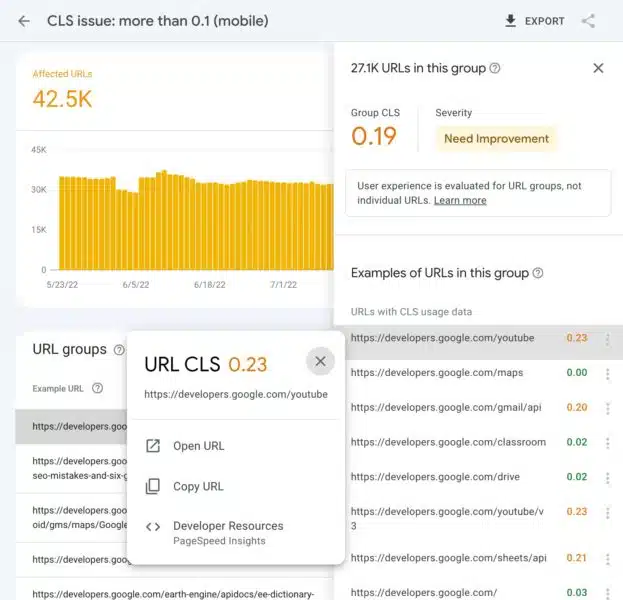Google Search Console adds URL-level data in Core Web Vitals report
Google also is now highlighting new stats on how improving Core Web Vitals metrics can improve user engagement and business metrics.
The Core Web Vitals report in Google Search Console is now showing URL-level data in the example URLs.
Google also has made some changes to the text in the report to make it clearer.
What it looks like. Google shared a screenshot via Twitter.

New issue classification. Google Search Console recently added new classifications. One of those changes was to the Core Web Vitals report. It now groups pages into two tables:
- Poor or Need improvement. The table below the charts lists all issues for pages with these statuses.
- Good. Click View data about usable pages under the summary chart.
Support page updated. The Core Web Vitals report support page has also undergone some significant revisions. Most are minor rewording. But of note:
The previous version of the Why page performance matters section focused on how longer page load times negatively impact bounce rates. Even though GA4 recently added bounce rate, all signs point to bounce rate as a metric of diminishing importance to Google.
That section has been revamped to highlight user engagement and business metrics:
• When a site meets the Core Web Vitals thresholds, research showed that users were 24% less likely to abandon page load.
• With each 100ms reduction in Largest Contentful Paint (LCP), web conversion rate for Farfetch increased by 1.3%.
• Reducing Cumulative Layout Shift (CLS) by 0.2 led Yahoo JAPAN to a 15% increase in page views per session, 13% longer session durations, and a 1.72 percentage point decrease in bounce rate.
• Netzwelt improved Core Web Vitals and saw advertising revenues increase by 18% and page views by 27%.
• Reducing CLS from 1.65 to 0 significantly uplifted domain rankings globally for redBus.
Core Web Vitals report, Google Search Console Help Center
Google also added a new Additional information section:
Click a URL in the Examples table of the issue details page to see more information about the represented by that URL, including other URLs in the group, and scores for those group members, if the URL has enough data to show.
The LCP, FID, and CLS status applies to the entire group. Some outlier URLs might have better or worse values on some visits, but 75% of visits to all URLs in the group experienced the group status shown.
You can click a URL in the group to run a PageSpeed Insights test against that URL. However, it’s useful to understand a few important differences between PageSpeed Insights and Core Web Vitals information:
• Core Web Vitals combines data and status into PageSpeed Insights generally shows data for individual URLs (unless the URL doesn’t have enough information by itself). The statistics for a specific URL in PageSpeed Insights might not match the group results in Core Web Vitals, because an individual URL might be an outlier in its group.
• Core Web Vitals URLs include URL parameters when distinguishing the page PageSpeed Insights strips all parameter data from the URL, and then assigns all results to the bare URL.
Why we care. These changes should make the Core Web Vitals report in Google Search Console more useful. Not being able to get detailed data in the URLs section has been a frustration for many SEOs.
Related stories